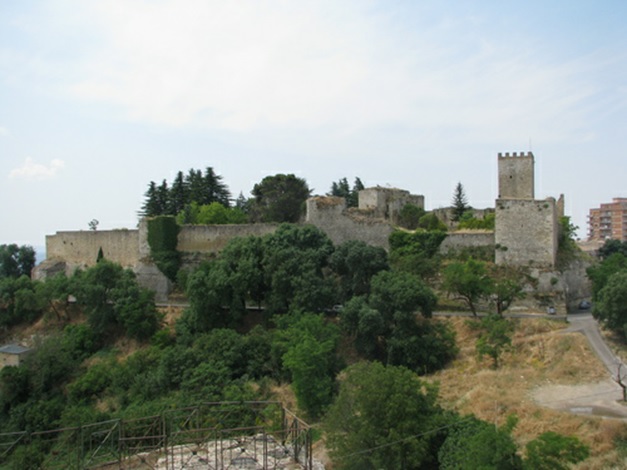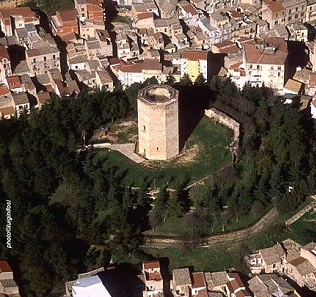ENNA

Enna Castello di lombardia

Enna Torre di Federico II
Le prime tracce di civiltà di nuovo al Neolitico 8000 aC. DC . I greci del V secolo aC. DC hanno dato il nome di Enna (Henna Dai Greci). Durante l'invasione romana Enna era già una delle fortezze più formidabili della Sicilia. Hanno avuto le peggio difficoltà da superare. Hanno dato il soprannominato "Urbs Inexpugnabilis" città inespugnabile.
Questo è l'unico posto della Sicilia che ha resistito alle invasioni barbariche fino al ritorno dei Romani d'Oriente nel 535. E 'rimasta una roccaforte bizantina fino all'arrivo degli arabi. Del posto di Calascibetta (Qualat-Shibeth) Loro assediarono la citta . Il periodo arabo era quella del Rinascimento. Governato da Kaid Emir, è stato identificato come una nuova capitale musulmana dell'isola.
Ci sono voluti quindici anni di sede narrazione Ruggero il Normanno, prima che uno dei suoi luogotenenti, il Signore Castrogiovanni può negoziare la resa con l'occupante, l'emiro Ibn Hamoud. Enna è perciò chiamato "Castrogiovanni" e tale rimase fino al periodo fascista.
Federico II, re di Sicilia e imperatore del Sacro Romano Impero tra il 1200 e il 1240, ha costruito la torre ottagonale.
Dopo una breve dominazione angioina e l'evento dei Vespri Siciliani (1282) gli Aragonese hanno preso il controllo della città. E 'diventato la residenza estiva del nuovo re Federico III d'Aragona nel 1314.
Les premières traces de civilisation remonteraient au Néolithique 8000 av. J.-C.. C’est les Grecs du Vème siècle av. J.-C. qui lui donnèrent le nom de Enna (Henna dai Greci). Pendant l’invasion romaine Enna était déjà une des plus redoutables places fortes de Sicile dont ils eurent les plus grandes difficultés à vaincre. Ils la surnommèrent « Urbs Inexpugnabilis» ville imprenable.
C’est la seule place de Sicile qui résista aux invasions barbares jusqu’au retour des Romains d’Orient en 535. Elle resta une place forte byzantine jusqu’à l’arrivée des Arabes qui l’assiégèrent en prenant appui sur le mont voisin de Calascibetta (Qualat-Shibeth). La période arabe fut celle de la renaissance. Régie par l'émir Kaid, elle a été identifiée comme une nouvelle capitale musulmane de l'île.
Il fallut quinze ans de siège au conte Roger le Normand, avant qu’un de ses lieutenants, le Seigneur Castrogiovanni puisse négocier la reddition avec l’occupant, l’émir Ibn Hamoud. Enna s’appela dès lors « Castrogiovanni » et le resta jusqu'à la période fasciste.
Frédéric II, roi de Sicile et Empereur du Saint-Empire romain germanique entre 1200 et 1240, fait construire la tour octogonale.
Après une courte domination angevine et l’évènement des Vêpres siciliennes (1282) les Aragonais passèrent maîtres de la ville. Elle devint la résidence estivale du nouveau Roi Frédéric III d’Aragon en 1314.
The first traces of civilization date back to the Neolithic 8000 BC. J.-C .. It is the Greeks of the 5th century BC. Which gave it the name of Enna (Henna dai Greci). During the Roman invasion Enna was already one of the most formidable fortresses in Sicily, the greatest difficulty of which they had to overcome. They nicknamed it "Urbs Inexpugnabilis" impregnable city.
It was the only place in Sicily that resisted the barbarian invasions until the return of the Romans of the East in 535. It remained a fortress byzantine until the arrival of the Arabs who besieged it by taking support on the neighboring mountain Of Calascibetta (Qualat-Shibeth) in the 9th century. The Arab period was that of rebirth. Governed by Emir Kaid, it was identified as a new Muslim capital of the island.
It took fifteen years of siege to Roger the Norman, before one of his lieutenants, Lord Castrogiovanni can negotiate surrender with the occupier, Emir Ibn Hamoud. Enna was called "Castrogiovanni" and remained so until the Fascist period.
Frederick II, King of Sicily and Emperor of the Holy Roman Empire between 1200 and 1240, built the octagonal tower.
After a short domination of Angevin and the event of the Sicilian Vespers (1282) the Aragonese passed masters of the city. It became the summer residence of the new King Frederick III of Aragon in 1314.
Questo è l'unico posto della Sicilia che ha resistito alle invasioni barbariche fino al ritorno dei Romani d'Oriente nel 535. E 'rimasta una roccaforte bizantina fino all'arrivo degli arabi. Del posto di Calascibetta (Qualat-Shibeth) Loro assediarono la citta . Il periodo arabo era quella del Rinascimento. Governato da Kaid Emir, è stato identificato come una nuova capitale musulmana dell'isola.
Ci sono voluti quindici anni di sede narrazione Ruggero il Normanno, prima che uno dei suoi luogotenenti, il Signore Castrogiovanni può negoziare la resa con l'occupante, l'emiro Ibn Hamoud. Enna è perciò chiamato "Castrogiovanni" e tale rimase fino al periodo fascista.
Federico II, re di Sicilia e imperatore del Sacro Romano Impero tra il 1200 e il 1240, ha costruito la torre ottagonale.
Dopo una breve dominazione angioina e l'evento dei Vespri Siciliani (1282) gli Aragonese hanno preso il controllo della città. E 'diventato la residenza estiva del nuovo re Federico III d'Aragona nel 1314.
Les premières traces de civilisation remonteraient au Néolithique 8000 av. J.-C.. C’est les Grecs du Vème siècle av. J.-C. qui lui donnèrent le nom de Enna (Henna dai Greci). Pendant l’invasion romaine Enna était déjà une des plus redoutables places fortes de Sicile dont ils eurent les plus grandes difficultés à vaincre. Ils la surnommèrent « Urbs Inexpugnabilis» ville imprenable.
C’est la seule place de Sicile qui résista aux invasions barbares jusqu’au retour des Romains d’Orient en 535. Elle resta une place forte byzantine jusqu’à l’arrivée des Arabes qui l’assiégèrent en prenant appui sur le mont voisin de Calascibetta (Qualat-Shibeth). La période arabe fut celle de la renaissance. Régie par l'émir Kaid, elle a été identifiée comme une nouvelle capitale musulmane de l'île.
Il fallut quinze ans de siège au conte Roger le Normand, avant qu’un de ses lieutenants, le Seigneur Castrogiovanni puisse négocier la reddition avec l’occupant, l’émir Ibn Hamoud. Enna s’appela dès lors « Castrogiovanni » et le resta jusqu'à la période fasciste.
Frédéric II, roi de Sicile et Empereur du Saint-Empire romain germanique entre 1200 et 1240, fait construire la tour octogonale.
Après une courte domination angevine et l’évènement des Vêpres siciliennes (1282) les Aragonais passèrent maîtres de la ville. Elle devint la résidence estivale du nouveau Roi Frédéric III d’Aragon en 1314.
The first traces of civilization date back to the Neolithic 8000 BC. J.-C .. It is the Greeks of the 5th century BC. Which gave it the name of Enna (Henna dai Greci). During the Roman invasion Enna was already one of the most formidable fortresses in Sicily, the greatest difficulty of which they had to overcome. They nicknamed it "Urbs Inexpugnabilis" impregnable city.
It was the only place in Sicily that resisted the barbarian invasions until the return of the Romans of the East in 535. It remained a fortress byzantine until the arrival of the Arabs who besieged it by taking support on the neighboring mountain Of Calascibetta (Qualat-Shibeth) in the 9th century. The Arab period was that of rebirth. Governed by Emir Kaid, it was identified as a new Muslim capital of the island.
It took fifteen years of siege to Roger the Norman, before one of his lieutenants, Lord Castrogiovanni can negotiate surrender with the occupier, Emir Ibn Hamoud. Enna was called "Castrogiovanni" and remained so until the Fascist period.
Frederick II, King of Sicily and Emperor of the Holy Roman Empire between 1200 and 1240, built the octagonal tower.
After a short domination of Angevin and the event of the Sicilian Vespers (1282) the Aragonese passed masters of the city. It became the summer residence of the new King Frederick III of Aragon in 1314.
